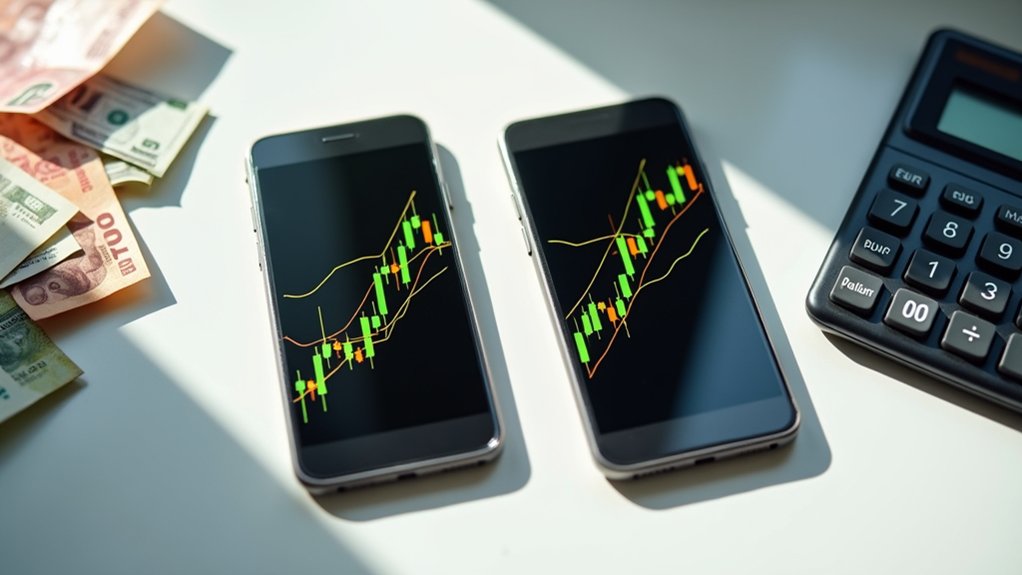Currency correlation in forex measures how two pairs move relative to each other, using coefficients from -1 to +1. Positive means they move together, negative means opposite directions, zero means random chaos. EUR/USD and GBP/USD typically march in lockstep, while EUR/USD and USD/CHF clash like enemies. Ignoring these relationships is a rookie mistake—traders can accidentally stack correlated positions and think they're diversified when they're actually exposed to the same market forces. The mechanics behind these movements reveal how economic ties and central bank decisions shape trading dynamics.

Most African forex traders stumble into currency correlation by accident—usually after watching two positions sink at exactly the same time and wondering what on earth just happened. Currency correlation measures how two forex pairs move relative to each other over a period of time. It's quantified using a correlation coefficient that ranges from -1 to +1. Positive correlation means pairs move in the same direction. Negative correlation means they move in opposite directions. A coefficient near zero indicates movements are random and unrelated.
The standard measurement tool is the Pearson correlation coefficient, though most Nigerian, Kenyan, or South African traders won't be doing manual calculations. Trading platforms provide live correlation data, and online calculators handle the heavy lifting. Time frames matter markedly—correlations can vary over one month, three months, six months, or a year of historical data. What looks correlated today might not be correlated next quarter.
Strong positive correlation falls between +0.75 and +1. EUR/USD and GBP/USD often move in tandem because of overlapping European economic drivers. AUD/USD and NZD/USD also tend to march together. Strong negative correlation sits between -0.75 and -1. EUR/USD and USD/CHF typically move in opposite directions, as do GBP/USD and USD/JPY. Anything between -0.75 and +0.75 is considered weak or negligible correlation—basically, the pairs do their own thing.
Several factors influence these relationships. Economic similarities between trading partners create stronger correlations. Monetary policy decisions from central banks can strengthen or weaken correlations overnight. Commodity prices matter for currencies tied to resources—AUD, CAD, and NZD correlate with oil or gold movements. Market hours play a role too; EUR pairs show intensified correlation during European trading sessions. During global crises, correlations spike as traders move in panicked herds. Market liquidity also affects correlation stability, as thinly traded pairs tend to show more erratic correlation patterns than major currency pairs with deep liquidity.
For traders in Ghana, Egypt, or Mauritius dealing with limited capital and high stakes, understanding correlation is critical. Trading non-correlated pairs reduces overall risk exposure. Negatively correlated pairs can hedge positions and offset potential losses. Positively correlated pairs amplify exposure to a market view—which cuts both ways. Overexposure to a single market factor happens when traders unknowingly stack correlated positions, thinking they're diversifying when they're actually doubling down. A Currency Correlation Matrix displays correlation degrees between multiple pairs simultaneously, allowing quick identification of relationships across an entire portfolio. Traders can use these correlation relationships to manage risk more effectively and optimize their overall trading strategies.
One important caveat: correlation does not imply causation. Synchronized movement isn't evidence of a direct causal link. Correlations shift due to economic events, policy changes, or plain old market sentiment. What worked last month might blow up this month. Volatility spikes when correlations suddenly change, reducing hedging effectiveness and increasing risk exposure faster than most African traders can react. Understanding order flow dynamics helps traders anticipate how correlation patterns might shift as different market participants enter or exit positions throughout the trading day. Regulatory authorities often publish compliance requirements that govern how brokers must disclose correlation risks to retail forex traders.
Common Questions
How Does South African Rand Correlation Affect Other African Currency Pairs?
The rand moves, everyone feels it. When ZAR swings on commodity prices or political drama in Pretoria, currencies across the continent follow—especially in Namibia, Lesotho, and Eswatini where the rand literally circulates.
Nigerian naira, Kenyan shilling, Ghanaian cedi all watch South Africa's interest rate decisions and investor mood. Trade ties amplify the ripple. A weak rand often signals broader African risk-off sentiment, dragging other pairs down. It's the regional heavyweight, whether anyone likes it or not.
Which African Broker Platforms Display Real-Time Currency Correlation Data for Traders?
Most African traders can't find real-time correlation data on local broker platforms—it's just not there.
South African traders have better options: Myfxbook shows live correlation tables for USDZAR pairs, Investing.com runs a correlation calculator across majors and exotics, and DailyFX offers ZAR-focused charting with news feeds.
ChartIQ and Coinigy integrate with some South African platforms for deeper analysis.
Outside South Africa? Good luck. The tools exist, but access remains limited across most of the continent.
Do Mobile Money Fluctuations in Kenya Impact Forex Correlation Strategies Locally?
Yes, they do. Kenya's mobile money transaction value dropped 19.6% to KES 636.2 billion by February 2025, shrinking retail liquidity that typically feeds forex accounts.
Traders now face fragmented digital flows as larger transfers shift to bank apps, diluting the predictive power mobile money trends once had on local FX sentiment. The decoupling of agent growth from transaction volume weakens correlation strategies relying on mobile money metrics alone. Less cash flow, more volatility in informal currency exchanges.
Can Nigerian Naira Restrictions Limit Effective Correlation Trading With Major Pairs?
Yes, they can. The Central Bank of Nigeria‘s forex restrictions throttle liquidity and create counterparty headaches for Nigerian traders trying to run correlation plays with EUR/USD or GBP/USD.
Limited naira access means fewer hedging options. The restrictions target domestic operations more than global pairs, sure—but they still choke diversification strategies.
Traders face delayed settlements and compliance nightmares. The new CBN FX Code and EFEMS system might ease some pain by boosting transparency, but correlation trading remains messier than it should be.
How Do Power Outages Across Africa Disrupt Live Correlation Monitoring During Trades?
Power cuts kill live correlation feeds instantly. When Nigeria's grid collapses or South Africa hits Stage 6 load shedding—289 days in 2023—streaming price data just stops. Traders lose real-time signals mid-session.
Backup generators help, but prolonged outages burn through diesel fast and overwhelm systems. Voltage spikes trash data packets. Result? Delayed feeds, missed arbitrage windows, and dead platforms exactly when correlation signals matter most.
African forex desks absorb these costs daily while watching opportunities evaporate in the dark.










